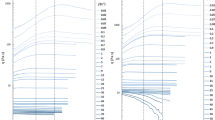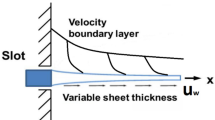Abstract
The knowledge of rheological behaviour of juices and fruit derivatives is very useful both in the prediction of their stability and in process design, and it depends on the type of juice and on the raw material with which they are produced. Most of the equations that have been used to quantify flow behaviour describe the evolution of shear stress with the change of shear rate. Nevertheless, the essential variable in equipment design is viscosity. In this way, a mathematical model to easily describe the evolution of apparent viscosity of these non-Newtonian fluids with the shear rate would be very useful. In this work, a mathematical expression has been developed, fitted to experimental data and compared with the Herschel–Bulkley one. The obtained parameters with concentrated orange juice followed these trends: equilibrium apparent viscosity (η ∞) scarcely changed with temperature. Static apparent viscosity (η 0) decreased with increasing temperature, contrary to what happened with the flow behaviour constant k.




Similar content being viewed by others
References
P.G. Crandall, C.S. Chen, R.D. Carter, Models for predicting viscosity of orange juice concentrate. Food Technol. 36, 245–252 (1982)
M.M.J. Cross, Rheology of non-Newtonian fluids: a new flow equation for pseudoplastic systems. J. Colloid. Sci. 20, 417–437 (1965)
A.L. Gabas, V.R.N. Telis, C.C. Tadini, J. Telis-Romero. Effect of time-dependent rheological behavior on the laminar flow of frozen concentrated orange juice in a circular pipe at subzero temperatures. 2nd Mercosur Congress on Chemical Engineering (2005)
J. Giner, A. Ibarz, S. Garza, S. Xhian-Quan, Rheology of clarified cherry juices. J. Food Eng. 30, 147–154 (1996)
A. Ibarz, J. Pagán. Consideraciones reológicas sobre zumos de frambuesa. Alimentación. Equipos y tecnología, 175–182 (1987).
A. Ibarz, J.E. Lozano, Caracterización reológica de pulpas concentradas de ciruela y melocotón. Rev. Esp. Cienc. Tecnol. Aliment. 32(1), 85–94 (1991)
A. Ibarz, F. Marco, J. Pagán, Rheology of persimmon juices. Fruit Process. 5(93), 182–187 (1993)
A. Ibarz, C. González, S. Esplugas, Rheology of clarified fruit juices. III: orange juices. J. Food Eng. 21, 485–494 (1994)
A. Ibarz, J. Giner, J. Pagán, V. Gimeno, S. Garza, Rheological behaviour of kiwi fruit juice concentrates. J. Texture Stud. 26, 137–145 (1995)
A. Ibarz, A. Garvín, J. Costa, Rheological behavior of sloe (Prunus spinosa) juices. J. Food Eng. 27, 423–430 (1996)
A. Maestro, Reología de espesantes celulósicos para pinturas al agua: Modelización y mecanismo de espesamiento. Ph. D. tesis (University of Barcelona, Spain, 2003)
S. Mizrahi, Z. Berk, Flow behaviour of concentrated orange juice. J. Texture Stud. 1, 342–355 (1970)
S. Mizrahi, Z. Berk, Flow behaviour of concentrated orange juice: mathematical treatment. J. Texture Stud. 3, 69–79 (1972)
S. Mizrahi, R. Firstenberg, Effect of orange juice composition on flow behaviour of six-fold concentrate. J. Texture Stud. 6, 523–532 (1975)
D.T. Tavares, M.R. Alcántara, C.C. Tadini, J. Telis-Romero. “Rheological properties of frozen concentrated orange juice at subzero temperatures.” 2nd Mercosur Congress on Chemical Engineering, (2005)
M.A. Rao, H.J. Cooley, A.A. Vitali, Flow properties of concentrated juices at low temperatures. Food Technol. 38, 113–119 (1984)
A.A. Vitali, M.A. Rao, Flow properties of low-pulp concentrated orange juice: serum viscosity and effect of pulp content. J. Food Sci. 49, 876–881 (1984)
A.A. Vitali, M.A. Rao, Flow properties of low-pulp concentrated orange juice: effect of temperature and concentration. J. Food Sci. 49, 882–888 (1984)
IFFJP, International Federation of Fruit Juice Producers Methods. Analysen analyses (Zug, Switzerland: Fruit-Union Suisse, Assoc. Svizzera Frutta, 1991)
R.P. Toralles, J.L. Vendruscolo, C. Tondo-Vendruscolo, Reologia de purê homogeneizado de pêssego: efeito da temperatura e concentraçâo. Braz. J. Food Technol. 9(1), 1–8 (2006)
Author information
Authors and Affiliations
Corresponding author
Rights and permissions
About this article
Cite this article
Falguera, V., Ibarz, A. A New Model to Describe Flow Behaviour of Concentrated Orange Juice. Food Biophysics 5, 114–119 (2010). https://doi.org/10.1007/s11483-010-9151-6
Received:
Accepted:
Published:
Issue Date:
DOI: https://doi.org/10.1007/s11483-010-9151-6




